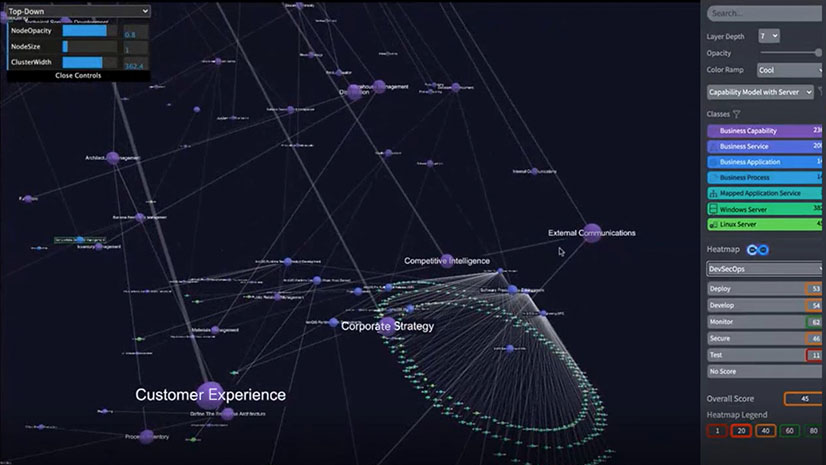Virtually every executive fighting to achieve key performance indicators covets a smart workplace. They long for a workplace where technology removes barriers to employee collaboration and improves productivity for the whole business. In short, they seek a workplace where technology keeps buildings and the business functions they contain humming along at peak efficiency.
A smart workplace can quickly account for all its assets—buildings, electrical systems, even open parking spaces. Executives and managers can see where things are happening and view useful details about any particular condition.
And it remembers everything, which helps decision-makers understand what has happened, what is happening, and what is likely to occur.
In the smart workplace, employees no longer need to know the access code to the front entrance—a proximity alert unlocks the gate based on who the employee is, where they are, and what level of access they have.
The facilities management team need not wonder if the business is losing water due to leaks; the smart water network reports the location of leaks as soon as they occur.
And the workplace services team no longer wonders where to find vacant office space for a team that’s being relocated. The smart workplace reports all open spaces on an intuitive map.
Moving up the Maturity Curve
Still, the smart workplace doesn’t happen overnight. For most companies, it evolves along a maturity curve that begins with awareness, then graduates to management and control; optimization; and eventually planning.
The results can be significant. A recent survey on the smart workplace found that 75 percent of companies that had adopted IoT—the backbone of the smart workplace—had increased profitability.
Melding the capabilities of IoT with location intelligence technology, including geographic information systems (GIS), can streamline a variety of time-consuming tasks for people working in a building or an office complex. Examples include predicting when a primary piece of equipment will fail, speeding up work orders, and locating employee mentors in real time.
To illustrate, let’s examine a hypothetical company at each stage of the maturity curve. We’ll explore what indoor intelligence looks like through two lenses—the HR executive and the facilities manager. The former must recruit, retain, and motivate a workforce that includes baby boomers, Gen Xers, Millennials, and Gen Zers, while the latter must ensure peak performance from the buildings and assets that facilitate their work.
Awareness
Awareness is the foundation of the smart workplace. For facilities executives, awareness means creating deep knowledge of the entire location—the buildings, their assets, and their functions.
A smart-facilities manager can pinpoint the location and condition of all assets, ranging from computer servers and conference rooms to company cars, defibrillators, and security cameras. An HR executive with high indoor intelligence understands how employees, teams, and office resources are distributed across campus, and how that affects productivity.
Awareness begins with measurement, which in the smart workplace is driven by IoT-based sensors. Those sensors reveal conditions that help decision-makers in facilities and HR grasp the state of the campus. Executives might need to track:
- How often the electric charging stations in a particular parking lot are used, and for what duration
- How many employees use an area with shared workspaces, and how that population fluctuates on certain days or across months
- Where lighting and HVAC systems are in low demand, possibly indicating that a space is underutilized
IoT-based sensors answer these questions, but that still creates just a partial view. To achieve full awareness, executives need to know not just what is going on but where and when conditions occur. For that, executives turn to a geographic information system (GIS).
GIS uses indoor mapping and analytical capabilities to reveal where and how workplace conditions affect employees and operations. The simple act of viewing those conditions on a map can be significant—boosting basic awareness, decreasing time to issue resolution, and sparking innovative ideas in a way that spreadsheets simply can’t.
Awareness sets the foundation for higher maturity stages of indoor intelligence. Once HR and operations executives understand what is happening throughout their facilities and workforce, they can begin to implement procedures for control, optimization, and planning.
Management and Control
The IoT backbone that facilitates workplace awareness also creates opportunities for management and control. Companies at this level of workplace maturity have automated many of the tasks that once required human oversight.
At the basic HR level, that could mean ensuring that employees working in certain roles have automated access to parking lots and designated buildings on campus, and that they are barred from accessing data that isn’t pertinent to their jobs.
At an advanced level, management and control might mean an automated workplace scheduling system that arranges employees’ meetings throughout the day and directs them to each one with a smart map of their location. When HR planners shift the location of individuals and teams, the campus map automatically reflects the changes.
For a facilities executive, real-time control of IoT-based devices can create efficiency in myriad ways. One of the most common is occupancy-based lighting and HVAC systems, which automatically conserve electricity when a space is vacant. In yet another scenario, a facilities manager might consult a campus map to see where the company’s security cameras are located, then to remotely reposition one for a better view of an unfolding incident.
The operating principle behind these scenarios is that most devices that can be connected via the IoT can also be controlled via the IoT, too. When one of those devices also connects to GIS, its status and location are visible on a map of the smart campus.

A business operations executive can, in a sense, see the future of the organization when tapping into a predictive map of the workplace, guiding decisions on budget and investments.
Optimization
A recent study found that employees who sit within 25 feet of a high-performing colleague see their own performance improve by 15 percent. With that in mind, HR executives can use location intelligence to map the optimal configuration of offices and teams, enhancing performance and strengthening collaboration.
Innovative HR executives are optimizing the smart workplace with a tool called a geofence—essentially a digital perimeter that can exist inside or outside a building. When someone crosses the perimeter, the smart device alerts the system to their presence. In the smart workplace, that can be helpful—for example, in arranging spur-of-the-moment gatherings when a project involving multiple teams is on deadline. Or it can help young workers connect with mentors for guidance.
Facilities managers can use geofencing to close work orders quicker. Consider an IT tech who passes a workstation that has an open repair ticket for a faulty monitor. Because the ticketing system is integrated with GIS and is location-aware, it understands both the location of the technician and the location of the pending repair job. The system can ping the technician’s phone with a reminder of the request, hastening the repair process.
Optimization takes many forms in the smart workplace, but underlying all of them are the capabilities established in the earlier maturity stages—awareness and control.
Planning
At the highest level of maturity, the intelligent workplace gives executives tools and insight to plan the future of the business.
It does this with two main resources—the data streaming in from the assets and employees on campus, and the technology that produces intuitive views of that information. We’re beginning to see this play out among leading-edge companies.
Consider the long-term capital decisions of whether to add a building on campus, or in the opposite scenario, to consolidate offices. For that strategic choice, HR decision-makers don’t rely on simple headcount numbers and org charts. Instead, they examine smart maps of employee activity. They look at data on seat occupancy, patterns in the lighting and HVAC systems, and badge entries and conference room usage. When viewed on smart, 3D maps, that data paints a clear picture of the need for more space—or the opportunity to consolidate.
Once those decisions are made, HR and facilities can work together to plan the best seating or office assignments based on team and performance dynamics. Consultants charge large fees to document what employees do and where they sit and then make recommendations on where they should be located. Modern GIS technology performs that kind of network analysis efficiently through a simple analysis program.
Like HR execs, operational decision-makers can use data from the smart workplace to plan budget allocations and capital investments. They can consult a GIS-powered 3D map for a quick view of asset status—for instance, the age of HVAC systems across campus, plus any past maintenance issues that would be relevant to a replacement decision.
On a smaller scale, they can zoom in on a building for details that affect the annual operating budget—which windows need to be recaulked, which parking lots need to be resurfaced, and more.
When that IoT-based data is incorporated into maps of the smart workplace, HR and facilities executives make better decisions, faster.
By seeing the building or campus holistically and understanding how employees and assets interact, business decision-makers can improve the efficiency of today’s workplace even as they plan tomorrow’s.
The Esri Brief
Trending insights from WhereNext and other leading publicationsTrending articles

December 5, 2024 |

July 25, 2023 |

November 12, 2018 |

February 1, 2022 |

July 29, 2025 |

July 14, 2025 |






